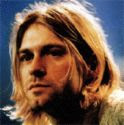In Utero
For 1993's In Utero, the band brought in producer Steve Albini, well-known for his work on the Pixies album Surfer Rosa. As Nevermind had brought in a new audience of listeners who had little or no experience with the alternative, obscure, or experimental bands Nirvana saw as their forebears, bringing in Albini appeared to be a deliberate move on Nirvana's part to give the album a raw, less-polished sound. For example, one song on In Utero featuring long periods of shrill feedback noise was titled, ironically, "Radio Friendly Unit Shifter" (in the industry, a "radio-friendly unit shifter" describes an "ideal" album: one capable of heavy radio play and ultimately selling many copies, or "units"). However, Cobain insisted that Albini's sound was simply the one he had always wanted Nirvana to have: a "natural" recording without layers of studio trickery. The sessions with Albini were productive and notably quick, and the album was recorded and mixed in two weeks for a cost of $25,000 at Pachyderm Studios in Cannon Falls, Minnesota.
Several weeks after the completion of the recording sessions, stories ran in the Chicago Tribune and Newsweek that quoted sources claiming DGC considered the album "unreleasable." As a result, fans began to believe that the band's creative vision might be compromised by their label. While the stories about DGC shelving the album were untrue, the band actually was unhappy with certain aspects of Albini's mixes. Specifically, they thought the bass levels were too low, and Cobain felt that "Heart-Shaped Box" and "All Apologies" did not sound "perfect". Longtime R.E.M. producer Scott Litt was called in to help remix those two songs, with Cobain adding additional instrumentation and backing vocals.
In Utero debuted at number one on the Billboard 200 album chart in September 1993. Time's Christopher John Farley wrote in his review of the album, "Despite the fears of some alternative-music fans, Nirvana hasn't gone mainstream, though this potent new album may once again force the mainstream to go Nirvana." Although commercially successful, the album did not achieve the same success as Nevermind. That fall, Nirvana embarked on its first major tour of the United States in two years. For the tour, the band added Pat Smear of the punk rock band Germs as a second guitarist.
Final Months And Cobain's Death
In November 1993, Nirvana performed for MTV Unplugged. The band opted to stay away from their most recognizable songs, playing only two of their hits, "All Apologies" and "Come as You Are". Grohl later related, "We knew we didn't want to do an acoustic version of Teen Spirit. ... That would've been horrendously stupid." The setlist also included a few relatively obscure covers, with members of the Meat Puppets joining the band for covers of three of their songs. While rehearsals for the show had been problematic, MTV Unplugged producer Alex Coletti noted that the actual taping went exceedingly well, with every song performed in one take and with the complete set lasting under an hour, which were both unusual for Unplugged sessions. Following the band's set-ending performance of Lead Belly's "Where Did You Sleep Last Night", Coletti tried to convince the band to perform an encore. "Kurt said, 'I can't top that last song.' And when he said that, I backed off. 'Cause I knew he was right." The band's performance debuted on MTV on December 14, 1993.
In early 1994, the band embarked on a European tour. Following a tour stop at Terminal Eins in Munich, Germany, on March 1, Cobain was diagnosed with bronchitis and severe laryngitis. The next night's show, at the same venue, was canceled. In Rome, on the morning of March 4, Love found Cobain unconscious in their hotel room and he was rushed to the hospital. A doctor from the hospital told a press conference that Cobain had reacted to a combination of prescription Rohypnol and alcohol. The rest of the tour was canceled, including a planned leg in the UK.
In the ensuing weeks, Cobain's heroin addiction resurfaced. An intervention was organized, and Cobain was convinced to admit himself into drug rehabilitation. After less than a week in rehabilitation, Cobain climbed over the wall of the facility and took a plane back to Seattle. A week later, on Friday, April 8, 1994, Cobain was found dead of an apparently self-inflicted shotgun wound to the head at his Seattle home, effectively dissolving Nirvana.
For 1993's In Utero, the band brought in producer Steve Albini, well-known for his work on the Pixies album Surfer Rosa. As Nevermind had brought in a new audience of listeners who had little or no experience with the alternative, obscure, or experimental bands Nirvana saw as their forebears, bringing in Albini appeared to be a deliberate move on Nirvana's part to give the album a raw, less-polished sound. For example, one song on In Utero featuring long periods of shrill feedback noise was titled, ironically, "Radio Friendly Unit Shifter" (in the industry, a "radio-friendly unit shifter" describes an "ideal" album: one capable of heavy radio play and ultimately selling many copies, or "units"). However, Cobain insisted that Albini's sound was simply the one he had always wanted Nirvana to have: a "natural" recording without layers of studio trickery. The sessions with Albini were productive and notably quick, and the album was recorded and mixed in two weeks for a cost of $25,000 at Pachyderm Studios in Cannon Falls, Minnesota.
Several weeks after the completion of the recording sessions, stories ran in the Chicago Tribune and Newsweek that quoted sources claiming DGC considered the album "unreleasable." As a result, fans began to believe that the band's creative vision might be compromised by their label. While the stories about DGC shelving the album were untrue, the band actually was unhappy with certain aspects of Albini's mixes. Specifically, they thought the bass levels were too low, and Cobain felt that "Heart-Shaped Box" and "All Apologies" did not sound "perfect". Longtime R.E.M. producer Scott Litt was called in to help remix those two songs, with Cobain adding additional instrumentation and backing vocals.
In Utero debuted at number one on the Billboard 200 album chart in September 1993. Time's Christopher John Farley wrote in his review of the album, "Despite the fears of some alternative-music fans, Nirvana hasn't gone mainstream, though this potent new album may once again force the mainstream to go Nirvana." Although commercially successful, the album did not achieve the same success as Nevermind. That fall, Nirvana embarked on its first major tour of the United States in two years. For the tour, the band added Pat Smear of the punk rock band Germs as a second guitarist.
Final Months And Cobain's Death
In November 1993, Nirvana performed for MTV Unplugged. The band opted to stay away from their most recognizable songs, playing only two of their hits, "All Apologies" and "Come as You Are". Grohl later related, "We knew we didn't want to do an acoustic version of Teen Spirit. ... That would've been horrendously stupid." The setlist also included a few relatively obscure covers, with members of the Meat Puppets joining the band for covers of three of their songs. While rehearsals for the show had been problematic, MTV Unplugged producer Alex Coletti noted that the actual taping went exceedingly well, with every song performed in one take and with the complete set lasting under an hour, which were both unusual for Unplugged sessions. Following the band's set-ending performance of Lead Belly's "Where Did You Sleep Last Night", Coletti tried to convince the band to perform an encore. "Kurt said, 'I can't top that last song.' And when he said that, I backed off. 'Cause I knew he was right." The band's performance debuted on MTV on December 14, 1993.
In early 1994, the band embarked on a European tour. Following a tour stop at Terminal Eins in Munich, Germany, on March 1, Cobain was diagnosed with bronchitis and severe laryngitis. The next night's show, at the same venue, was canceled. In Rome, on the morning of March 4, Love found Cobain unconscious in their hotel room and he was rushed to the hospital. A doctor from the hospital told a press conference that Cobain had reacted to a combination of prescription Rohypnol and alcohol. The rest of the tour was canceled, including a planned leg in the UK.
In the ensuing weeks, Cobain's heroin addiction resurfaced. An intervention was organized, and Cobain was convinced to admit himself into drug rehabilitation. After less than a week in rehabilitation, Cobain climbed over the wall of the facility and took a plane back to Seattle. A week later, on Friday, April 8, 1994, Cobain was found dead of an apparently self-inflicted shotgun wound to the head at his Seattle home, effectively dissolving Nirvana.








June 15, 2009 at 8:09 PM
unplugged in new york..
masih sedap didengar sampai kini..
beremosi tapi berani..
hebat lah mereka..
haha
xpe..
manusia tetap mati
biar semangat mereka kekal di sini.